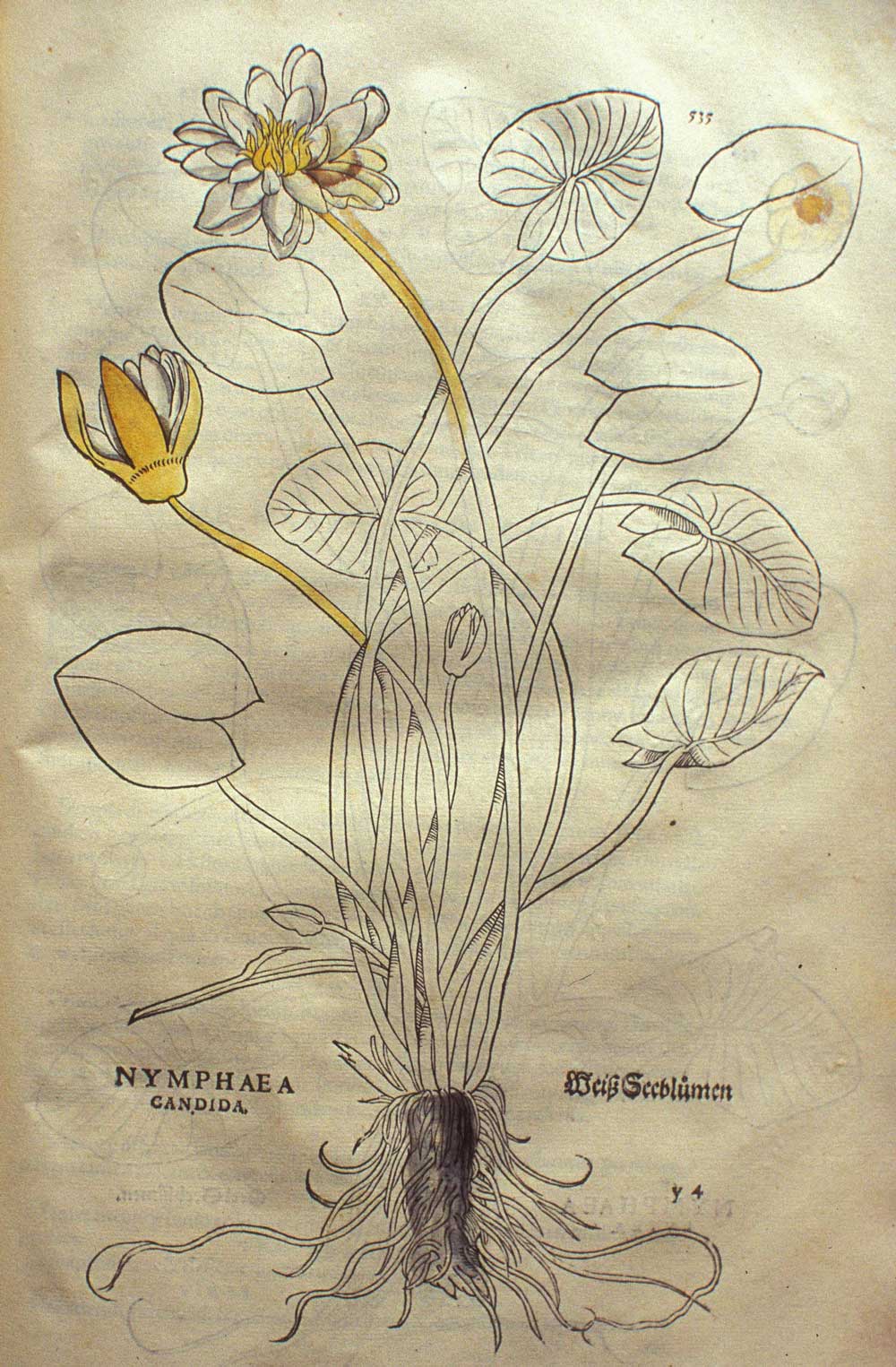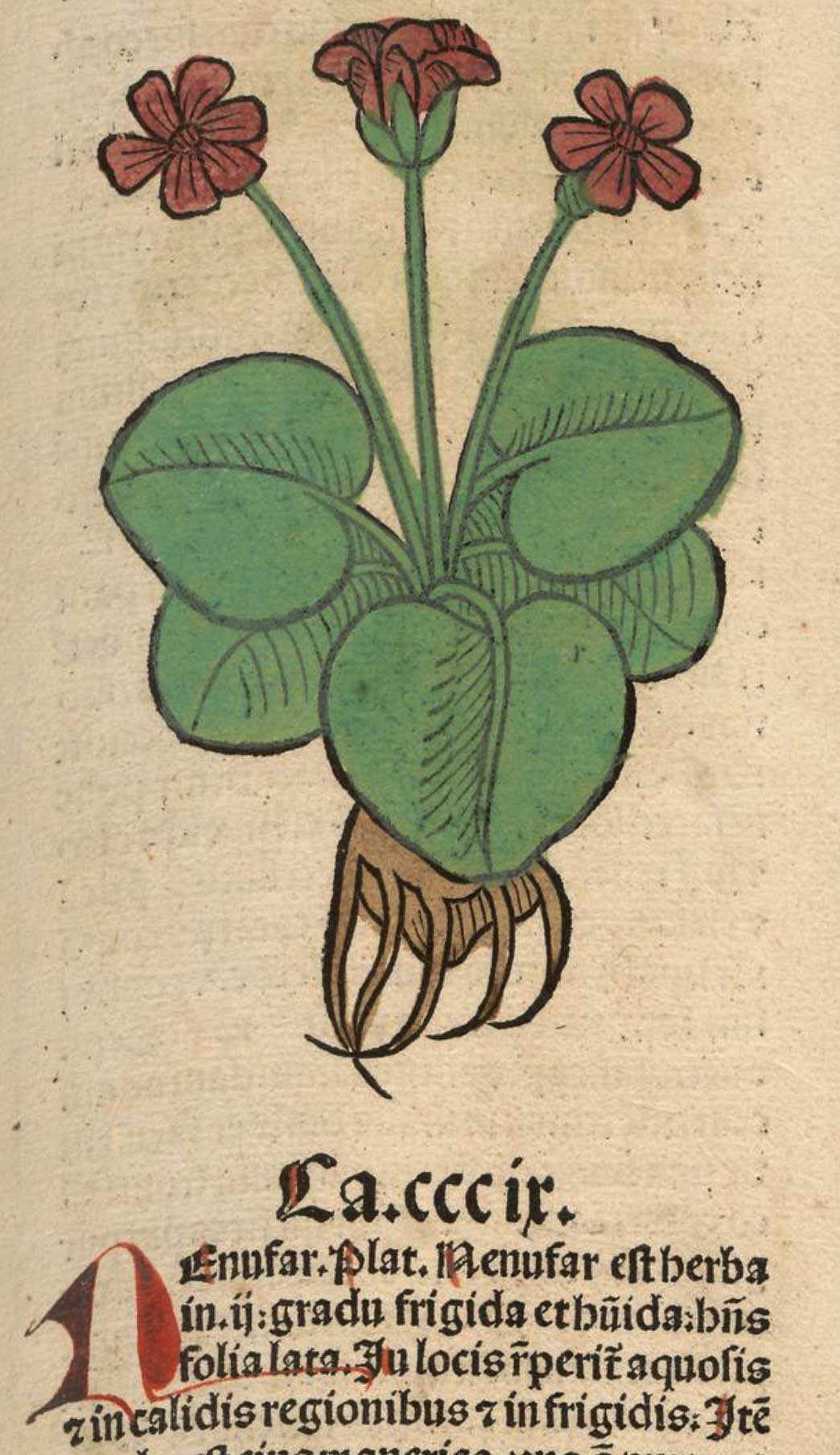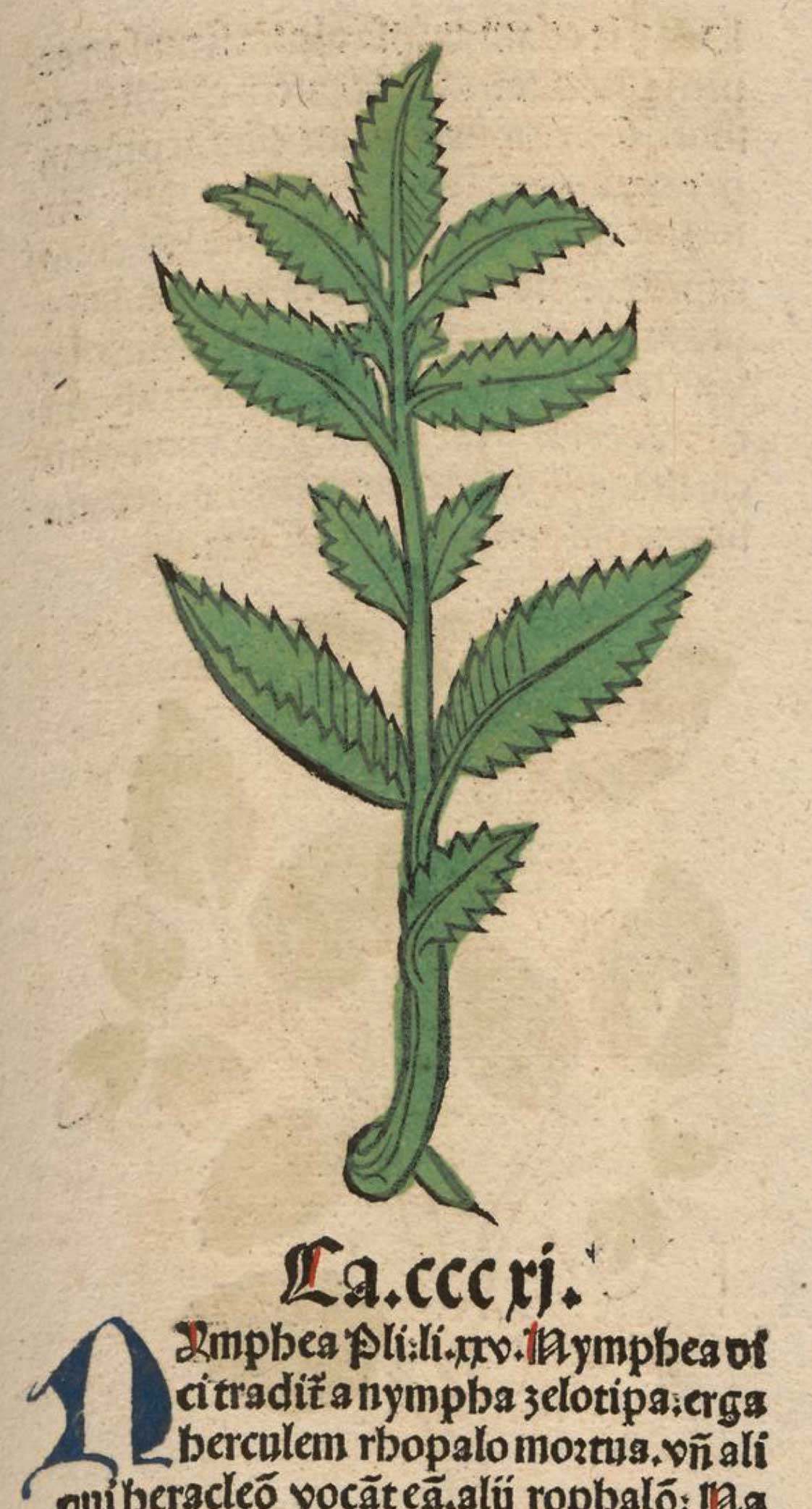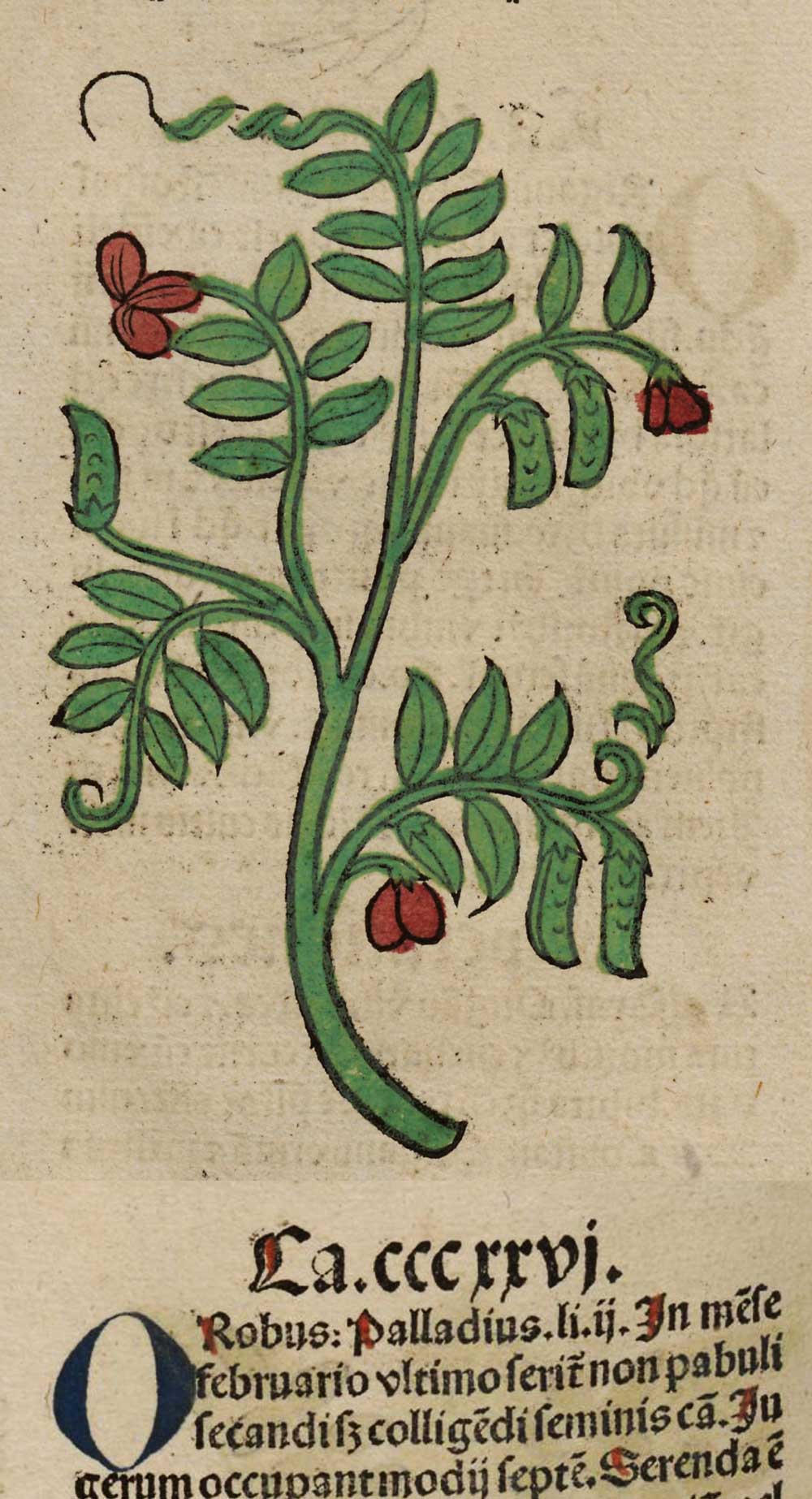“…than the nenuphar and Nymphaea heraclia to ribald monks…”
Among the examples of pairings whose antipathies are not as vehement as the hatred thieves have of a certain usage of Pantagruelion.
Notes
Nenufar
Nymphea
Papaver
Nymphaea

Plate caption: Nymphaea candida Weiss Seeblumen
Taxon: Nymphaea alba L.
Ancient Greek: numfaia
Modern English: white water lily
nymphea Heraclia
Nymphaea nata traditur nympha zelotypia erga Herculem mortua—quare heracleon vocant aliqui, alii rhopalon a radice clavae simili—ideoque eos qui biberint eam xii diebus coitu genituraque privari. laudatissima in Orchomenia et Marathone. Boeoti mallon vocant et semen edunt. nascitur in aquosis, foliis magnis in summa aqua et aliis ex radice, flore lilio simili et, cum defloruit, capite papaveris, levi caule. secatur autumno radix nigra, in sole siccatur. adversatur lieni. est et alia nymphaea in Thessalia, amne Penio, radice alba, capite luteo, rosae magnitudine.
According to tradition nymphaea was born of a nymph who died of jealousy about Hercules—for this reason some call it heracleon, others rhopalon because its root is like a club—and therefore those who have taken it in drink for twelve days are incapable of intercourse and procreation. The most valued kind grows in the district of Orchomenos and at Marathon. The Boeotians call it mallon, and eat the seed. It grows in watery places, with large leaves on the top of the water and others growing out of the root; the flowers are like the lily, and when the blossom is finished a head forms like that of the poppy; the stem is smooth.d In autumn is cut the root, which is dark, and is dried in the sun. It reduces the spleen. There is another kind of nymphaea growing in the River Penius [the Penius is a river of Colchis: the Thessalian river is the Peneus. Probably the mistake is Pliny’s, but one MS. (d) reads Peneo] in Thessaly. It has a white root, and a yellow head of the size of a rose.
nenuphar
Venerem in totum adimit, ut diximus, nymphaea Heraclia, eadem semel pota in XL dies, insomnia quoque veneris a ieiuno pota et in cibo sumpta. inlita quoque radix genitalibus inhibet non solum venerem sed et affluentiam geniturae. ob id corpus alere vocemque dicitur. adpetentiam veneris facit radix e xiphio superior data potui1 in vino, item quam cremnon agrion appellant, ormenos agrios cum polenta contritus.
Nymphaea heraclia, as I have said, takes away altogether sexual desire; a single draught of it does so for forty days; sexual dreams too are prevented if it is taken in drink on an empty stomach and eaten with food. Applied to the genitals the root also checks not only desire but also excessive accumulation of semen. For this reason it is said to make flesh and to improve the voice. Sexual desire is excited by the upper part of xiphium root given in wine as a draught; also by the plant called cremnos agrios and by ormenos agrios crushed with pearl barley.
nymphea Heraclia
Plantes réfrigératives ordonnées aux moines pour amortir les feux de concupiscence.
nymphæ heraclia
Nymphea heraclia, allusion mythologique: «Nymphæa nata traditur nympha zelotypia erga Herulem mortua,» Pline, XXV, 37. Pline décrit deux espèces de ce dernier: celui dont la fleur est semblable au lis, notre Nymphea alba, L., et celui à fleur jaune qui est probablement notre Nufar luteum, Sm. En disant nénufar et nymphæa, Rableais entend-il marquer qu’il fait la diffférence des deux espèces? Pline mentionne déjà (XXV, 37) les vertus antiaphrodisiaques de la racine de nénufar: «Eos qui biberint eam duodecim diebus coitu geniturâque privari». (Paul Delaunay)
Nenuphar…
Encore une fois, la plupart de ces exemples se retrouvent dans le De latinis nominibus de Charles Estienne. Le nenufar et la semence de saule sont des antiaphrodisiaques. La ferula servait, dans l’Antiquité, à fustiger les écoliers (cf. Martial, X, 62-10).
Nymphœa Heraclia
Vraisemblablement, deux variétés de nénuphars; leurs vertus antiaphrodisiaques sont une occasion d’attaquer la paillardise des moines; cf. aussi la la semence de saule recommandée aux nonnains.
heracleum
heracleum. [modern Latin (C. Linnæus Systema Naturæ 1735), formed on Greek Herakleia, the plant named after Heracles.]
A plant of a genus of large herbs of this name, belonging to the family Umbelliferæ and native to northern temperate regions; cow-parsnip or hogweed.
1787 W. Withering In botany Arrangem. Brit. Plants (ed. 2) I. 287 Heracleum.
1824 J. E. Smith Eng. Flora II. 101 Heracleum. Cow-parsnep.
1847 H. C. Watson Cybele Britannica I. 451 This [Angelica sylvestris] and the Heracleum are the two most widely distributed species of their order.
nymphea
nymphæa. Also nymphea. [Latin, adaptation of Greek numfaia, fem. of numfaioj sacred to the nymphs. So French nymphæa, nymphéa.]
The common white or yellow water-lily; a genus of aquatic plants including these and other species.
1562 William Turner A new herball, the seconde parte ii. (1568) 66 The roote of the whyte Nymphea is black,..of the yelow..whyte.
1601 Philemon Holland, translator Pliny’s History of the world, commonly called the Natural historie II. 222 Nenuphar is called in Greeke Nymphæa.
1673 Ray Journ. Low C. (1693) II. 97 Their Alterative Physick consists of Coolers, and Anodyns, as Nymphæa, Poppy, Endive.
1741 Complete family piece and country gentleman and farmer’s best guide ii. iii. 374 In the Water Tubs, the yellow Nymphea or Water Lilly.


